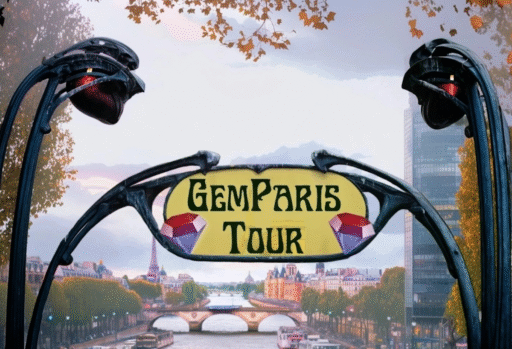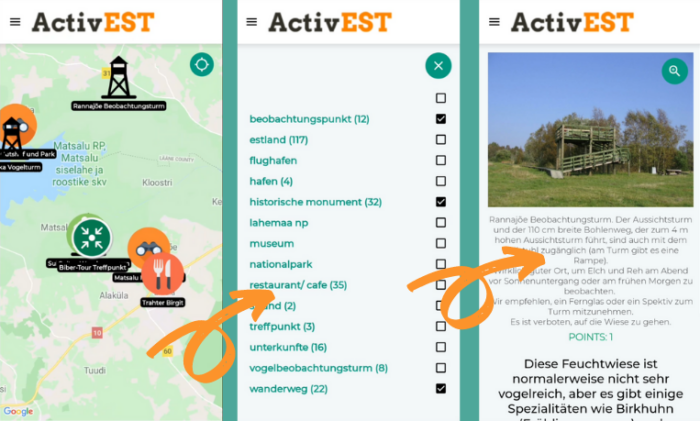We interviewed Bert Rähni from Natourest / Activest naturetours company in Estonia about their self-guided tours. After creating tours over 10 years, they have switched to Loquiz to compose and run tours. Watch video:
Transcript
Hello, Bert! We are here today with Bert, who is one of the founders of the Natourest. And the idea was to talk about Loquiz and how it can beused to create self-guided virtual tours. So, firstly, I would ask you why did Natourest decide to collaborate with Loquiz to develop these smart-guided tours?
We have been making these smart-guided tours for almost 10 years and we have been using and searching for different softwares during this whole time.And since I know the Loquiz team very well, we have collaborated before and I trust them. Also, they did a very similar thing where location-related software was developed which repeatedly still came into discussions and we thought we too could make a raw app or a suitable software for travel and culture companies. At some point we decided that we must start developing this collaboration, and that is how it went.
But why should smart-guided tours be done with a special software?
We searched for different options but in the end we realised that if you want to provide good quality tours, and with a travel company you continuously search for ways to optimize and make work more efficient, like every decent software, it needs to offer a better quality to the client on the one hand and on the other hand it will make back-office work remarkably easier.
You mentioned quality, which are the quality-related or in general the biggest problems when creating self-guided tours? Which problems can be solved with software like Loquiz?
Well, we are specialised to nature trips and our clients often visit places far from cities and hike in the forests to see the animals and birds. Therefore, the first requirement is that the software truly works everywhere in the forest. So, having, for example, web-based solutions, require people to always be connected to the Internet with their smart device. Even though in Estonia there is good connection everywhere,still, some real forest area may not be so great.
The first step was that it needs to work well for the client without good connection and it needs to be fast when locating or routing efficiently.
The software really working for the client is number one for us. The second important requirement for us was based on the knowledge that the information necessary to enter is quite extensive, meaning the client will receive a pretty big information package from us. It needs to be easy to follow, the points must able to be turned on and off, it must be comfortable to use. Those are two important factors for us.
When the tour is already taking place, what is the most difficult aspect of supporting the client in the so-called back office?
There have been some type of technical problems,for example, when taking automatically the location of accommodation and entering it without checking it manually, then it might be a bit shifted for the client.
Or then there are again two sides: one side is the Loquiz side regarding the platform and the other side is the information we enter where problems might also occur.
Whether a location is not open or the information does not correspond to what we have entered. The information might not always be actual, it needs to be monitored well by ourself. But since so far we have every time welcomed our clients at the airport and given them an instruction or a briefing, where we show them precisely and let them test out the software, such technical problems have appeared very few times.
I think that if we begin to sell it without meeting the clients, we definitely need to think thoroughly about giving instructions to the client ahead of time should be done really well so that the client would know how to work with the software. Actually, nothing is too complicated but still imagine you are at a foreign location, you land at the airport, sit into the car and have to start using it immediately, everything still would start working.
You mentioned that you have been creating self-guided tours for a really long time now, with what and how have you been making them so far?
We started with Google MyMaps. Then in between for a few years we worked with a software called Mapme.
And then these last two-three years with Loquiz. In the beginning both Google Maps and Mapme had their advantages and disadvantages. But now it is clear that special software from Loquiz is the best as it is specially developed and adapted for this which makes our work significantly easier.
For how many days on average one tour lasts?
For us approximately the duration of an average tour is a week.
It is quite a lot of content, how long did it take to move from one platform to another one, meaning transferring the complete tour to Loquiz?
We entered the content for, let’s say, for four-five days, so a week can be counted for transferring all the points, if I remember correctly, we transferred about two or three hundred locations over to the new system.
Since the transfer of the points between the different platforms is quite problematic, then we had to enter everything again manually, we didn’t know any other possibilities.
That it was easier having the old platform in front of us as an example, it still took time.
Compared to all of the previous tools, what do you feel has become the easiest?
I think the main aspect, when looking from the viewpoint of a tourism or tour operator, is that these tours are much easier to make, concretely creating the tours. In Google Maps and My Maps there was also a possibility to endlessly create these maps for yourself. But in Mapme the number of maps was limited, meaning every time you had to pay quite a lot extra. But with Loquiz you can with ease make as many maps as you like, the types of maps you want, the kinds of versions you desire, and in turn clone the next versions and from there the next ones.
This is the main advantage, if you look from the side of a tour operator.
Besides you, how many other team members of Natourest had to contribute to the creation of the tour?
We did it with the four of us, it also differed as there was more work to do with entering the points.
We as well had a division – some entered the points and did the technical work, while others focused more on starting up the product.So yes, in total there was four of us working on it.
Maybe you want to bring out such an exciting detail that you are very proud of regarding self-guided tours that run with Loquiz now? Or what do you find very interesting?
An advantage, based on our specifics again, is definitely that with Loquiz we can send people to natural places where there is no connection. Loquiz is an app that the user has downloaded to their phone and on an ongoing basis it does not require Internet connection.
For us it makes the whole process much easier as we don’t have to worry at all whether there is Internet and what is going on there in general.
Okay. What would you point out as the most complicated aspect that made you scratch your head and took time when you developed a tour with Loquiz?
There are rather a lot of opportunities, as I mentioned before, for entering all kinds of points and locations along with making maps from those. This would automatically mean that it is more difficult, all is somewhat more complicated.
For example, compared to Google My Mapsiga it is seemingly more complex. That is one factor that must be taken into consideration. First you need to make the technical side clear to yourself as it takes a little bit of time to delve and understand how it all works. That was the main challenge in the beginning.
What are the future plans regarding self-guided tours and their content?
We plan to actively develop them further, our plans are big. I believe they are very suitable for companies, like us, who are focused on nature activities. By all means, we plan on improving the content on an ongoing basis to then develop new tours and so far we have found quite many new partners who sell our trips. I think this progress will continue with great momentum. If only the external environment would get somewhat better.
Yes.
Could you bring an example where you see yourself how the software of self-guided tours could help save money or time?
Well in that sense… If we tune the software to its best ability and the information as meaningful as possible, then of course it will help with saving money. Situations may arise where there is no necessity of sending along a human guide on the trips. This is a significant saving. In addition, the flexibility which accompanies since you can always decide for yourself during the trip what you are doing and where you are going. For instance, on account of weather or whatever you desire, your mood or feelings, you can decide what you will do today and where you will go. In that sense the save of time and money is constant.
We have been discussing the so-called side of the tour operator but let’s hop over to the clients for a moment.
What are the clients like who mostly take interest in such self-guided tours?
Well, they are clients who value more private trips, in general privacy, and perhaps they are the discoverer type too who would not go on group tours. Meanwhile they do not want to spend too much of their time on preparation and are comfortable enough to not immerse into all local details – what are really the best sights to see, which accommodations have the best price-quality ratio and where it is best to eat.
For example, I have been abroad to test for my own professional interest, that if you go to a destination without using any help from the local tour operator and on-site start discovering it, I have noticed it takes about two-three days to understand what are coolest places and where it is worth and not worth to go. So, if while travelling you want to save those two three days and still travel privately and independently you want to to save time by using the help of local specialists who will straightaway recommend you the best places, then making smart-guided tours with software like Loquiz is a great opportunity. So the content entered by Natourest is valuable. From one side, yes, there are clients
who really want to travel and explore. From the other side, there are clients who value their time and attention high enough just to not only count on themselves.
Since Natourest has a long experience with self-guided tours, could you compare the feedback from clients regarding the old tours based on the old software and the current new tours made with Loquiz?
Well, one important advantage is that Loquiz indeed works. Like I have repeatedly said it does not require ideal Internet everywhere and the entire instructional side works everywhere and anytime with Loquiz. Secondly, filtration of the points and filtration of the information are both significantly easier. You can turn on and off specifically if you want to look at, I don’t know, hiking trails, you can add the hiking trails and then you will see all of the hiking trails of that specific region. If you want to look at bird observation towers, then you turn on the bird observation towers and can see. Previously all of this information was in one bundle together which made the searching process pretty difficult. In addition, we gave quite a lot of paper material to the clients to take on their journey, a chunk of paper is quite uncomfortable to carry along and sort out the information. In the first year with Loquiz we still included them due to the inertia but last year we didn’t anymore. Okay, that is great progress if there is less paper material included.
Yes. However, we still include an atlas just because it is easier to look at while flicking through the pages and observing the surroundings. We have also noticed that some of our clients are more conservative, they still like to have an atlas in their hands and actually it is very comfortable to look up places from there.
What do you feel yourself usually requires the most explaining? Teaching-guiding?
As a matter of fact the Loquiz mobile application side is quite simple,
there is not much to explain there besides navigating between the different menus and switching the points on and off. There is not much else to bring forth.
If we think further in Estonia or maybe even outside of Estonia, what would you say to the owners of other tourism companies who have not created self-guided tours yet or have created them with a paper-pen method without using any software? What would you recommend to them before choosing a software?
Well. The first thing is the simplicity of your own work because at first the idea of “oh, I will use a software” is okay, whether it is free or whatever. And it is okay in the beginning but later in the course of daily work when new tours in larger quantities need to be created for multiple clients, then the ease of use of the user’s own travel agency building is very-very important. It is definitely worth thinking about for yourself! And in general, I think that is the future.
What do you think, Natourest creates quite long tours, will day tours or shorter tours also be justified to use a software like Loquiz?
I believe it does justify. Then it is definitely a little different from us who meet every client in person to talk and guide. Then it just has to be that the client can download it from somewhere and the instructions given to the client need to be good enough to figure it out independently. But I am sure it would fit! And it makes this kind of spontaneous decision-making easier for the client. Nowadays at all, due to the current situation, the spontaneous moment factor is so high that I think many of the decisions will be made in the short-term in tourism in the coming years. Using a software such as Loquiz might make it easier for the client.
In your opinion, which countries in Europe could potentially be great locations for self-guided tours?
I think all European countries. I couldn’t point out any like this or state that one does not fit. I think it is a topic all over Europe.
You are in the nature tourism field. In addition to nature tourism, are there any other kinds of tourism companies that could benefit from it or who would benefit the most?
I reckon it is exactly the same with culture tourism, even though perhaps it is not that fitting or, let’s say, necessary for such travel agents who organize beach vacations for clients who plan on spending a full week at the beach. What would they do with this kind of software? They visit the beach and that’s it. At the same time on these trips usually, whenever I go, I still take a couple of days to discover the surroundings. In such occasions one-day tours with Loquiz are ideal. And again
the flexibility will let you decide for yourself when you will go depending on the weather, your state of mind, children’s moods – whatever provided by the flexibility.
In short, all travel companies that are connected with exploring and viewing new locations most definitely can benefit from it.
As a bonus question, can you recommend a software besides self-guided software that a tourism company could use? Which kind of softwares does Natourest use, if it isn’t a secret?
I must say for us as a small business the main priority was the same tour organizing software. We don’t have this kind of all-inclusive software for the back office in use today, we have used tables ourselves.
That work was online, but still tables for the back office.
For the customer management software we use Trello and our website is made quite traditionally with WordPress.
I really cannot point out something very special at the moment.
Okay. And one bonus question: from the entire conversation today, is there a thought or aspect you would want to specifically emphasize? What would be the one message to say about this topic?
I think the main message is indeed that short notice periods and flexibility will evidently be one of the key issues in the coming years of tourism, one of the key problems for tourism companies and for the clients as well. Also, thinking about how to be flexible and further from there what the software of flexibility enables.
Alright. Thank you for this conversation and these insights into self-guided tours which is quite a new and innovative field. You’re welcome!
Thank you and goodbye!
Goodbye!
Related stories

We’ve launched a new version of the GemParis Tour with improved logic and graphics. It uses the Creator, so you...

Loquiz was on TV alongside IZI Morocco! Our users in Rabat, Morocco, hosted a fantastic event to launch their Loquiz...

Playing games is fun, but creating games is even better. What if you generate a profit from your own game...
Start free trial to bring your ideas to life
Sign up and create games, tours, team events and educational content that captures peoples' attention
Start from the scratch or use templates to kickstart!

